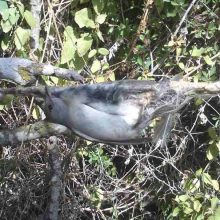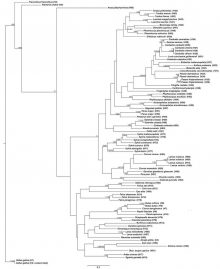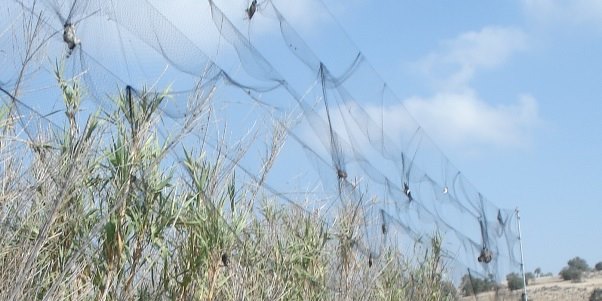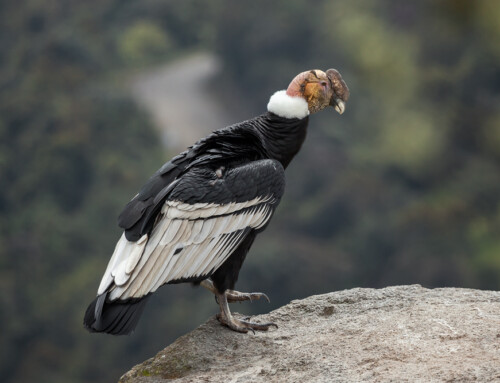How could DNA barcoding be an ace up the sleeve against poaching?
LINKED PAPER
DNA barcoding of bird species in Cyprus: a tool for conservation purposes. Dimitriou, A.C, Forcina, G., Papazoglou, C., Panayides, P., Guerrini, M., Crabtree, A., Barbanera, F. and Sfentourakis, S. 2017. Bird Conservation International. DOI: 10.1017/S0959270916000472. VIEW
Millions of migratory and other birds are trapped, traded and consumed each year in most of the Mediterranean Basin, especially in the Middle East, North Africa and Malta (Brochet et al. 2016). Although regulation of legal hunting activities has been a central tenet of the environmental policies of all EU countries, the degree and extent of illegal bird killing has been assessed only very recently at the European level (Hirschfeld and Heyd 2005, Brochet et al. 2016).
Cyprus is a well-known biodiversity hotspot, with the island avifauna comprising around 400 species (including six endemic taxa), 117 of which are listed in Annex I of the Birds Directive (2009/147/EC). Among the very few Mediterranean countries, Cyprus has established a systematic monitoring scheme of illegal bird killing (BirdLife Cyprus 2015a, Brochet et al. 2016). Trapping, trading and consumption of small songbirds, although illegal, are still quite common on the island. Historical roots of this phenomenon go back to times when migratory birds offered much needed protein as a food supplement while more recently it also provided, due to the increase in scale, remarkable profits (Franzen 2010, 2013). According to BirdLife Cyprus, more than 2 million individuals representing 153 different species are trapped illegally each year in Cyprus. Moreover the island of Cyprus seems to hold by far the highest mean number of individual birds illegally harvested each year among Mediterranean countries (195.9 birds per 100 persons and 248.3 birds per km2 every year; Brochet et al. 2016). Additionally, three of the top 20 trapping locations in the whole Mediterranean in terms of largest numbers of individuals being killed per year are found in Cyprus, the highest on the list (Famagusta area) being situated on the island (Brochet et al. 2016).
Non-selective capture methods (lime-sticks, nets), in combination with the widely used tape luring, account for the highest number of species illegally caught. The main target species is the Blackcap Sylvia atricapilla; however, more than 40 species lump with the Blackcap under the collective term ambelopoulia (the local name for small migrating songbirds), such as the Lesser Whitethroat Sylvia curruca, Garden Warbler S. borin, various species of pipits, shrikes and Phylloscopus warblers, as well as the two endemic species (Cyprus Warbler S. melanothorax and Cyprus Wheatear Oenanthe cypriaca). Trapping of these species is illegal while the only ones that can be legally hunted are those listed in the transposition in Cyprus law of the Birds Directive 2009/147/EC, among the passerines, the Skylark Alauda arvensis, and some thrushes (Common Blackbird Turdus merula, Song Thrush T. philomelos, Redwing T. iliacus, and others).

© Panicos Panayides
It is well known that in Cyprus trapped migrating birds are preserved in vinegar and/or cooked before they are served illegally in restaurants. When enforcement authorities raid restaurants or perform searches in private houses, plucked birds cannot be identified as, apart from the feathers, the head and legs are also usually removed. Hence, it is very difficult to argue in law courts about which species they are and whether they were acquired legally or not.

© Panicos Panayides
The Department of Biological Sciences (University of Cyprus), in collaboration with BirdLife Cyprus, the Game and Fauna Service (Ministry of Interior, Cyprus) and the Department of Biology (University of Pisa, Italy), funded by the A.G. Leventis Foundation, launched a project aiming to assist in fighting illegal trapping and hunting of Cyprus birds following a DNA barcoding approach. This approach proved to be a very useful tool, taking advantage of the opportunity to identify species from deformed, destroyed, cooked or otherwise processed tissues even in traces. A Cytochrome oxidase subunit I (COI) sequence database of all bird species resident in Cyprus, as well as those most commonly trapped (both targeted and common by-catch species) was created. The database could be used to identify confiscated or otherwise collected samples of tissue or whole birds, even when these samples have been processed (e.g. cooked), badly preserved or are not morphologically identifiable.

Click on figure to view larger.
In total DNA was successfully amplified from 103 specimens representing 81 bird taxa (resulted in 93 different haplotypes) including ill-preserved samples such as shed feathers, biological traces (blood), even human-processed tissue (cooked or/and preserved in vinegar) by using a combination of nested and semi-nested PCR with different primer pairs. This result is very important considering that DNA investigation of similarly processed bird specimens will be demanded often, this being the most common way of preserving and serving small songbirds in Cyprus. Consequently, the protocols followed and the dataset produced herein will provide the necessary background for future species identification of various and differently preserved tissues.
Phylogenetic reconstructions provided supporting evidence against published criticisms on the effectiveness of DNA-barcoding when based on a single gene fragment and dealing with closely related taxa (e.g. Moritz and Cicero 2004, Meyer and Paulay 2005, Wiemers and Fiedler 2007). In fact, the phylogenetic reconstruction in Figure 3 is in large agreement with known bird phylogeny (Jetz et al. 2012, Prum et al. 2015), all named species are identified as separate taxa, and the monophyly for almost all genera including more than one species has been recovered as well as many sister-clade relationships at the genus level.
Furthermore, the results of this work, as well as other published studies with larger datasets, show that specimen identification through DNA barcoding is effective and reliable, even when they belong to sister taxa. Indeed, extremely low intraspecific genetic distances at the selected region in contrast with relatively high interspecific distances among congeneric species allow for safe identification. Diagnostic polymorphisms within the genus Sylvia including one of the main targeted species, Sylvia atricapilla, were found (Table 1).

Application of our experimental protocol and DNA barcoding database provides a tool to compare wildlife forensic evidence, enabling Cypriot enforcement authorities to come with conclusive evidence regardless of whether suspects were caught in the act or not. Far beyond persecution of offenders, tools such as DNA barcoding allow also for the reduction of efforts needed to collect poaching evidence in the field. This, in turn, may result in a much lower risk for police officers or Game and Fauna Service personnel, as genetic evidence is objective beyond any in situ dispute. Furthermore, the ability to identify plucked, processed or cooked birds can strongly contribute to the reduction of poaching for increasing income, since some restaurants are an important component of the illegal market. According to existing laws, restaurant owners who illegally serve birds are considered equally guilty with the trappers. DNA-based specimen identification will allow for more effective investigation of local restaurant owners and trappers possessing plucked birds. Thus, the use of DNA barcoding as a forensic investigative tool may represent an effective deterrent for anyone that might possess protected species.
References
BirdLife Cyprus 2015. Update on illegal bird trapping activity in Cyprus. Nicosia, Cyprus: BirdLife Cyprus VIEW
Brochet, A.-L., Van Den Bossche, W., Jbour, S., Ndang’Ang’a, P. K., Jones, V. R., Abdou, W. A. L. I., Al-Hmoud, A. R., Asswad, N. G., Atienza, J. C., Atrash, I., Barbara, N., Bensusan, K., Bino, T., Celada, C., Cherkaoui, S. I., Costa, J., Deceuninck, B., Etayeb, K. S., Feltrup-Azafzaf, K., Figelj, J., Gustin, M., Kmecl, P., Kocevski, V., Korbeti, M., Kotrošan, D., Laguna, J. M., Lattuada, M., Leităo, D., Lopes, P., López- Jiménez, N., Lucić, V., Micol, T., Moali, A., Perlman, Y., Piludu, N., Portolou, D., Putilin, K., Quaintenne, G., Ramadan- Jaradi, G., Ružić, M., Sandor, A., Sarajli, N., Saveljić, D., Sheldon, R. D., Shialis, T., Tsiopelas, N., Vargas, F., Thompson, C., Brunner, A., Grimmett, R. and Butchart, S. H. M. 2016. Preliminary assessment of the scope and scale of illegal killing and taking of birds in the Mediterranean. Bird Conserv. Internatn. 26: 1–28. VIEW
Franzen, J. 2010. Emptying the skies. The New Yorker (July 26). VIEW
Franzen, J. 2013. Last song for migrating birds. National Geographic. VIEW
Hirschfeld, A. and Heyd, A. 2005. Mortality of migratory birds caused by hunting in Europe: bag statistics and proposals for the conservation of birds and animal welfare.\ Jagdbedingte Mortalitaet von Zugvoegeln in Europa: Streckenzahlen und Forderungen aus Sicht des Vogelund Tierschutzes. Berichte zum Vogelschutz. 42: 47–74. VIEW
Jetz, W., Thomas, G. H., Joy, J. B., Hartmann, K. and Mooers, A. O. 2012. The global diversity of birds in space and time. Nature 491: 444–448. VIEW
Meyer, C. P. and Paulay, G. 2005. DNA barcoding: Error rates based on comprehensive sampling. PLoS Biology 3: 1–10. VIEW
Moritz, C. and Cicero, C. 2004. DNA barcoding: Promise and pitfalls. PLoS Biology 2: 1529–1531. VIEW
Prum, R. O., Berv, J. S., Dornburg, A., Field, D. J., Townsend, J. P., Lemmon, E. M. and Lemmon, A. R. 2015. A comprehensive phylogeny of birds (Aves) using targeted next-generation DNA sequencing. Nature 256: 569–573. VIEW
Wiemers, M. and Fiedler, K. 2007. Does the DNA barcoding gap exist? – a case study in blue butterflies (Lepidoptera: Lycaenidae). Front. Zool. 4: 1–16. VIEW
Image credit
Featured image: Trapped birds in mistnets © Panicos Panayides
If you want to write about your research in #theBOUblog, then please see here.





